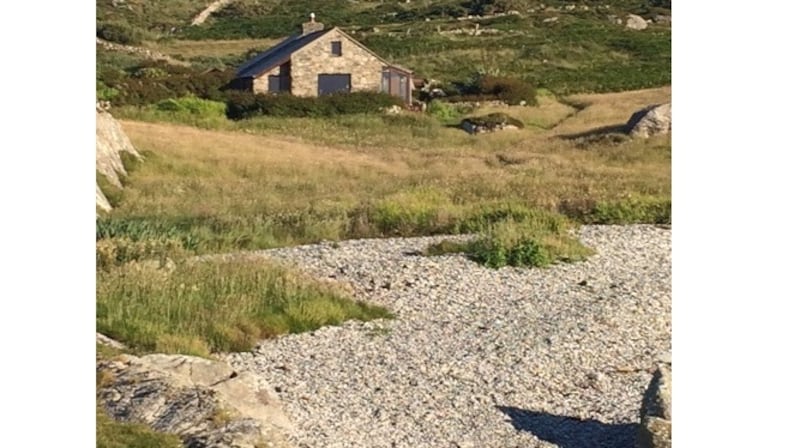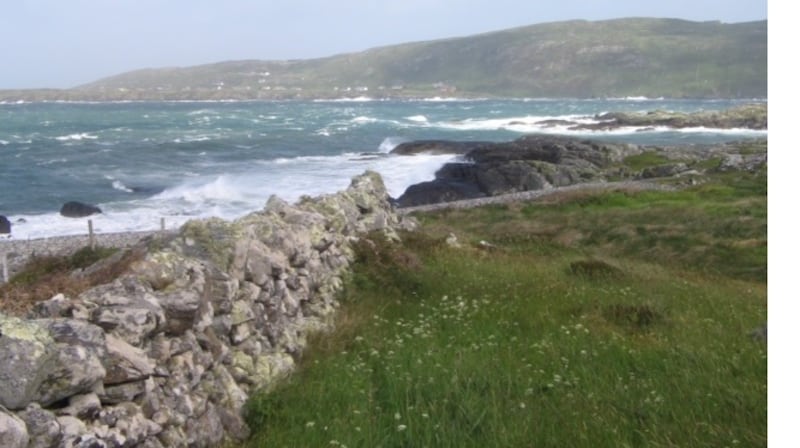Every summer we walked along a stony seashore, picking up bits of driftwood, coconut husks and metal buoys thrown up by the winter storms. On the adjacent fields the last Ice Age had left behind unusual rocks. The boys loved clambering over them, kings of their castles.
A little higher up the bank was a ruin nestled between stone walls, one of many in this part of Connemara. It had been abandoned, maybe 100 years before. There was no living to be had among rocks, poor land and uncertain fishing. I would often pick my way up through the abundant meadow to sit by the gable end. In front of me the bay spread out; inside of me flowed a seemingly infinite peace. Drawn often to the same spot, I would sit, watching the sun go down, almost rooted, as that sense of being cradled persisted.
Many years passed before it became ours: those four stone walls with that perfectly preserved gable end leaning inward at a rakish angle. Having followed an instinct, we now had to decide what to do next. Raze it to the ground and build a modern bungalow, sited broadside to the howling Atlantic gales? Not really. We decided to disregard the original planning permission.


A journey of discovery into ancient ways began. With Estyn Evans and his Irish Folkways as our guide, we learned that the foot print of our ruined cottage was typical of the vernacular architecture. The thatch had disintegrated long ago. Whenever John O'Donohue came upon similar abandoned dwellings he felt a sense of yearning for those who had to leave their homestead to the mercy of the elements, their spirits still lingering among the mossy stones.
We decided upon rescue and resurrection. Reinstatement is what the planning people called it. So be it. Right then blackberries flourished behind that perfectly gimpy gable end. Cows found shelter inside on bad days. And yet it was quite obvious where windows, doors, the fireplace had been, so long ago. A horseshoe embedded in a side wall led us to presume it might have been a byre dwelling. A house in which man and beast shared shelter and warmth.
The late Michael King said it had been a shop. A shop for the islanders who put into the Famine harbour below. What did it sell? Nothing much. Tea, tobacco, sugar and flour, maybe.
Restoration
Over a span of five years we planned the restoration of the ruin, nestling snugly between two small streams and below a rocky ledge.
A lean-to addition seemed to make sense. A kitchen, bathroom and small hall were modern conveniences we did not want to do without. The biggest discussion though, circled around that westerly gable-end wall. Piseogaí they may be, but would we invite bad luck by pulling down the gable and adding on to the west end? Not likely. Our neighbours reminded us how lives were affected when others did just that in the past. There were many examples of just how risky it could be. Yet the best view facing the sea was from that gable end. Finally the compromise of a large window set westward towards the setting sun proved acceptable all round.

Gradually the restoration began. The first year saw walls raised slightly, a side extension built and the whole structure roofed. Windows and doors, made of solid hardwood in Roundstone, were put in the following year. Our builder, the late Brian King, found a huge wooden beam riddled with woodworm on a restoration project.
Unique mantelpiece
It had most certainly been salvaged from the sea, marine borers bearing witness to its journey. For six months it lay outside after treatment with Cuprinol. Now inside, it has found its place as a unique mantelpiece. Below it, a cavernous fireplace has been reimagined, complete with an ancient iron crane from which to hang pots or a kettle. Ready hot water is the prerequisite for mugs of steaming tea, then and now.
Nothing will ever be square in this house, especially the rooms and roof. No really straight lines. Time and weather have squeezed the original rectangle into a rhombus. Never mind. The location is what matters – the ever-changing, often restless waters of the Atlantic ocean to the front. A hillock at the back gives shelter from the easterly winds. Old fuchsia hedges determine the shape of the small garden. Dry stone walls encircling the dwelling do the rest. Perfect feng shui, according to the wisdom from the east. Five years of planning and saving. Five years of building before the reinstated ruin settled back into the land, the way a cow might lie down – content. Cows always know the best place.

















